Effects of Foreign Metal Object on Soft-Switching Conditions of Class-E Inverter in WPT
Abstract
:1. Introduction
2. Idealized Operation of the Class-E Inverter in WPT System
3. Effects of Foreign Metal Object on Coil Parameters
3.1. Effects of Different Frequencies
3.2. Effects of Different Positions of the Metal Plate
4. Effects of Foreign Metal Object on Soft-Switching Conditions
4.1. Foreign Metal Object is Near the Receiver Coil
4.2. Foreign Metal Object Is Near the Transmitter Coil
4.3. A Foreign Metal Object Appears at the Outer Side of Two Coils
5. Experiment and Analysis
5.1. Prototype
5.2. Experimental Result and Analysis
- (1)
- When the iron plate is placed along the line l1, the ZVS soft-switching condition could be maintained. It can be seen from Figure 16 that the interval, after vDS decreases to zero and before the power MOSFET turns on, gets larger as the iron plate approaches the receiver coil. However, it will increase the voltage stress of the power MOSFET and reduce the output power as the iron plate detunes the resonant network of the receiver system.
- (2)
- On contrast, when the iron plate is placed along the line l2, it is obvious from Figure 17 that the soft-switching conditions will be invalid immediately as long as the iron plate is involved. Also, the hard-switching phenomenon will become severer, while the transmitter current I1 will increase to transfer more power. However, it will jeopardize the system and cause the power MOSFET or the compensation capacitors to be burnt out.
- (3)
- It is noted that, when the iron plate is placed along the line l3, the Class-E inverter is slightly hard-switched when d3 equals to 15 cm. It confirms that the iron plate appearing at the outer side of two coils has a smaller impact on the system, although the hard-switching phenomenon will become obvious when d3 reaches 5 cm.
6. Conclusions
Author Contributions
Funding
Conflicts of Interest
References
- Kuyvenhoven, N.; Dean, C.; Melton, J.; Schwannecke, J.; Umenei, A.E. Development of a foreign object detection and analysis method for wireless power systems. In Proceedings of the 2011 IEEE Symposium on Product Compliance Engineering Proceedings, San Diego, CA, USA, 10–12 October 2011. [Google Scholar]
- Fukuda, S.; Nakano, H.; Murayama, Y.; Murakami, T.; Kozakai, O.; Fujimaki, K. A novel metal detector using the quality factor of the secondary coil for wireless power transfer systems. In Proceedings of the 2012 IEEE MTT-S International Microwave Workshop Series on Innovative Wireless Power Transmission: Technologies, Systems, and Applications, Kyoto, Japan, 10–11 May 2012. [Google Scholar]
- Wang, Y.C.; Chiang, C.W. Foreign Metal Detection by Coil Impedance for EV Wireless Charging System. In Proceedings of the EVS28 International Electric Vehicle Symposium Exhibition, KINTEX, Goyang, Korea, 3–6 May 2015. [Google Scholar]
- Mi, C.C.; Buja, G.; Choi, S.Y.; Rim, C.T. Modern Advances in Wireless Power Transfer Systems for Roadway Powered Electric Vehicles. IEEE Trans. Ind. Electron. 2016, 63, 6533–6545. [Google Scholar] [CrossRef]
- Liu, G.; Mrad, N.; Xiao, G.; Li, Z.; Ban, D. Metallic Environmental Effect on RF-Based Energy Transmission. IEEE Antennas Wirel. Propag. Lett. 2012, 11, 925–928. [Google Scholar] [CrossRef]
- Oodachi, N.; Ogawa, K.; Obayashi, S.; Shoki, H. Wireless power transfer system minimizing an influence of a desk. In Proceedings of the 2012 IEEE MTT-S International Microwave Workshop Series on Innovative Wireless Power Transmission: Technologies, Systems, and Applications, Kyoto, Japan, 10–11 May 2012. [Google Scholar]
- Jiang, H.; Brazis, P.; Tabaddor, M.; Bablo, J. Safety considerations of wireless charger for electric vehicles—A review paper. In Proceedings of the 2012 IEEE Symposium on Product Compliance Engineering Proceedings, Portland, OR, USA, 5–7 November 2012. [Google Scholar]
- Pávó, J.; Badics, Z.; Bilicz, S.; Gyimóthy, S. Efficient Perturbation Method for Computing Two-Port Parameter Changes Due to Foreign Objects for WPT Systems. IEEE Trans. Magn. 2017, 54, 1–4. [Google Scholar] [CrossRef]
- Zhang, P.; Yang, Q.; Zhang, X.; Li, Y.; Li, Y. Comparative Study of Metal Obstacle Variations in Disturbing Wireless Power Transmission System. IEEE Trans. Magn. 2017, 53, 1–4. [Google Scholar] [CrossRef]
- Krishnan, S.; Bhuyan, S.; Kyaw, O.; Kumar, V.P.; Wenjiang, W. Effect of proximal metallic objects on the performance of wireless charging systems for electric vehicles. In Proceedings of the 2012 IEEE International Symposium on Radio-Frequency Integration Technology (RFIT), Singapore, 21–23 November 2012. [Google Scholar]
- Wiengarten, R.; Reising, V.; Vosshagen, T.; Turki, F. About the heating of foreign metallic objects in magnetic field of wireless power transfer by cars. In Proceedings of the PCIM Europe 2015—International Exhibition and Conference for Power Electronics, Intelligent Motion, Renewable Energy and Energy Management, Nuremberg, Germany, 19–20 May 2015. [Google Scholar]
- Tan, L.; Li, J.; Chen, C.; Yan, C.; Guo, J.; Huang, X. Analysis and performance improvement of WPT systems in the environment of single non-ferromagnetic metal plates. Energies 2016, 9, 576. [Google Scholar] [CrossRef]
- Jeong, N.S.; Carobolante, F. Enabling wireless power transfer though a metal encased handheld device. In Proceedings of the Wireless Power Transfer Conference, Aveiro, Portugal, 5–6 May 2016. [Google Scholar]
- Jeong, S.Y.; Kwak, H.G.; Jang, G.C.; Choi, S.Y.; Rim, C.T. Dual-purpose Non-overlapping Coil Sets as Metal Object and Vehicle Position Detections for Wireless Stationary EV Chargers. IEEE Trans. Power Electron. 2017, 33, 7387–7397. [Google Scholar] [CrossRef]
- Jeong, S.Y.; Thai, V.X.; Park, J.H.; Rim, C.T. Self-inductance Based Metal Object Detection with Mistuned Resonant Circuits and Nullifying Induced Voltage for Wireless EV Chargers. IEEE Trans. Power Electron. 2018, 1. [Google Scholar] [CrossRef]
- Low, Z.N.; Casanova, J.J.; Maier, P.H.; Taylor, J.A.; Chinga, R.A.; Lin, J. Method of Load/Fault Detection for Loosely Coupled Planar Wireless Power Transfer System with Power Delivery Tracking. IEEE Trans. Ind. Electron. 2010, 57, 1478–1486. [Google Scholar] [CrossRef]
- Raab, F.H. Idealized operation of the class E tuned power amplifier. IEEE Trans. Circ. Syst. 1977, 24, 725–735. [Google Scholar] [CrossRef]
- Celozzi, S.; Araneo, R.; Lovat, G. Electromagnetic Shielding, 1st ed.; John Wiley & Sons: Hoboken, NJ, USA, 2008; pp. 21–33. [Google Scholar]
- Raab, F.H. Effects of circuit variations on the class E tuned power amplifier. IEEE J. Solid-State Circ. 1978, 13, 239–247. [Google Scholar] [CrossRef]
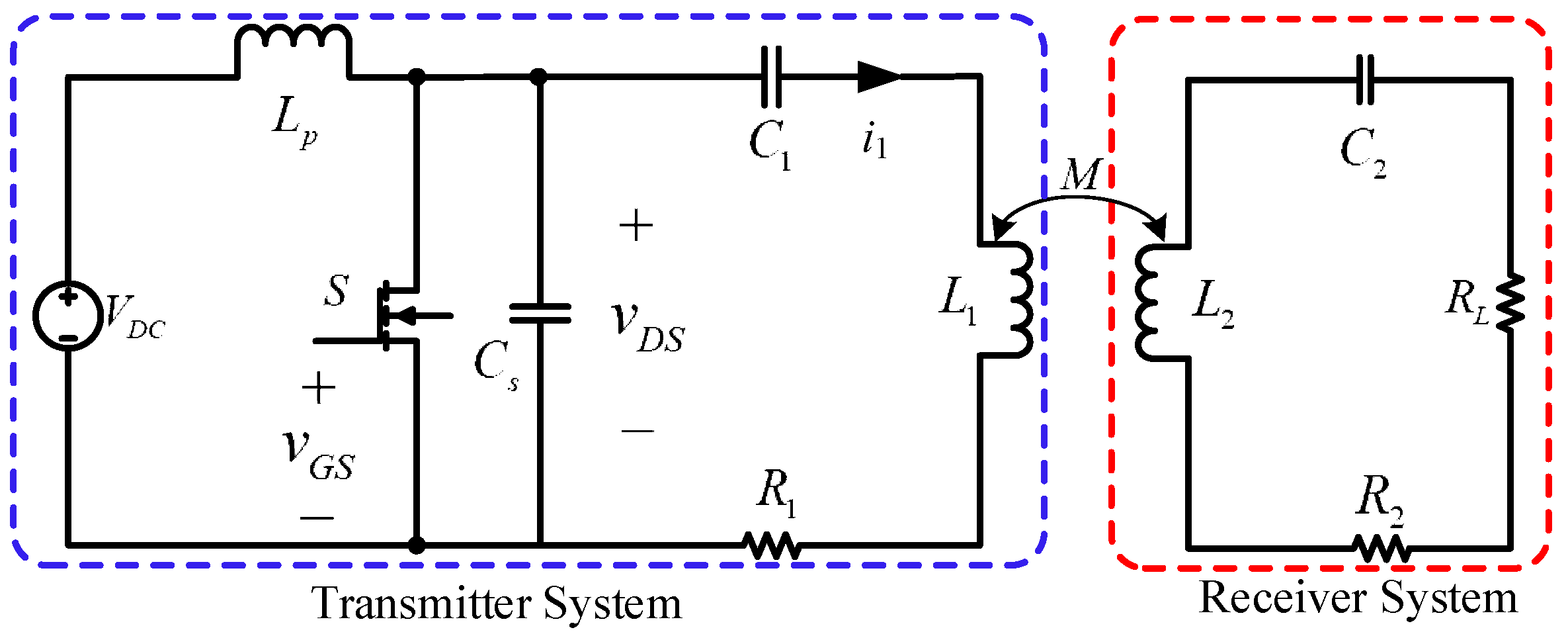
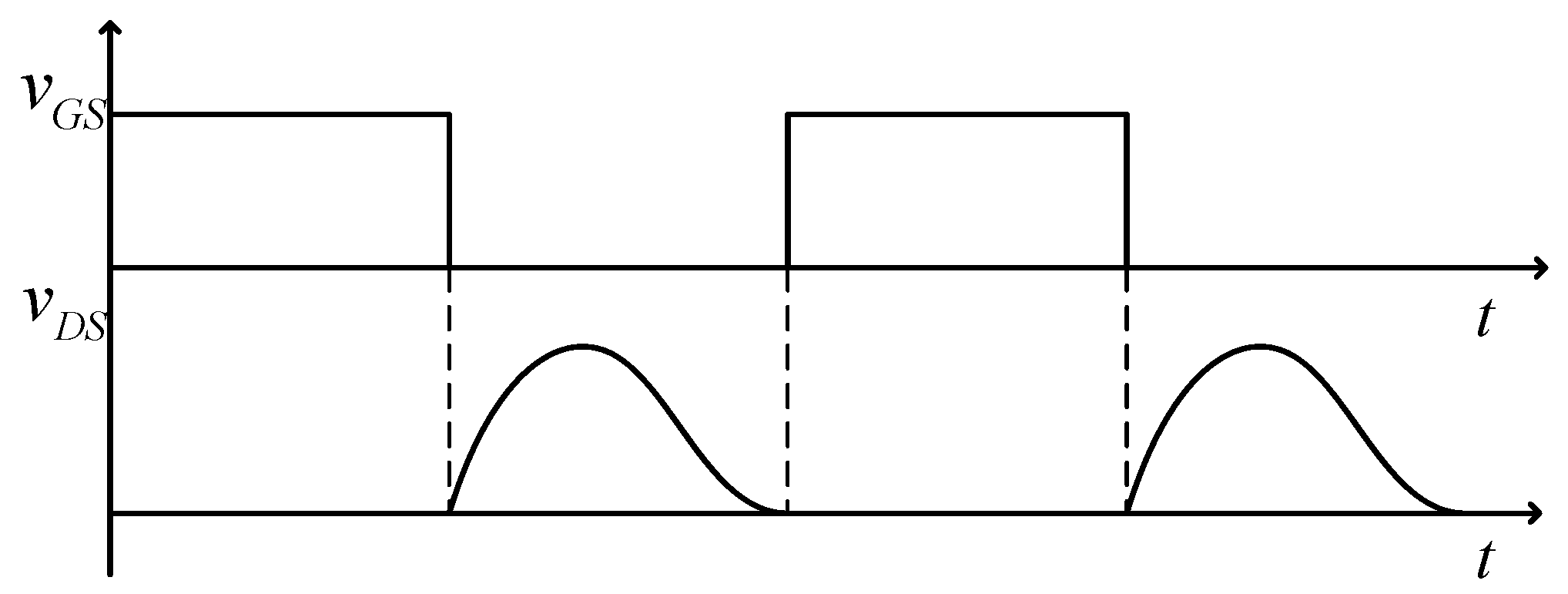


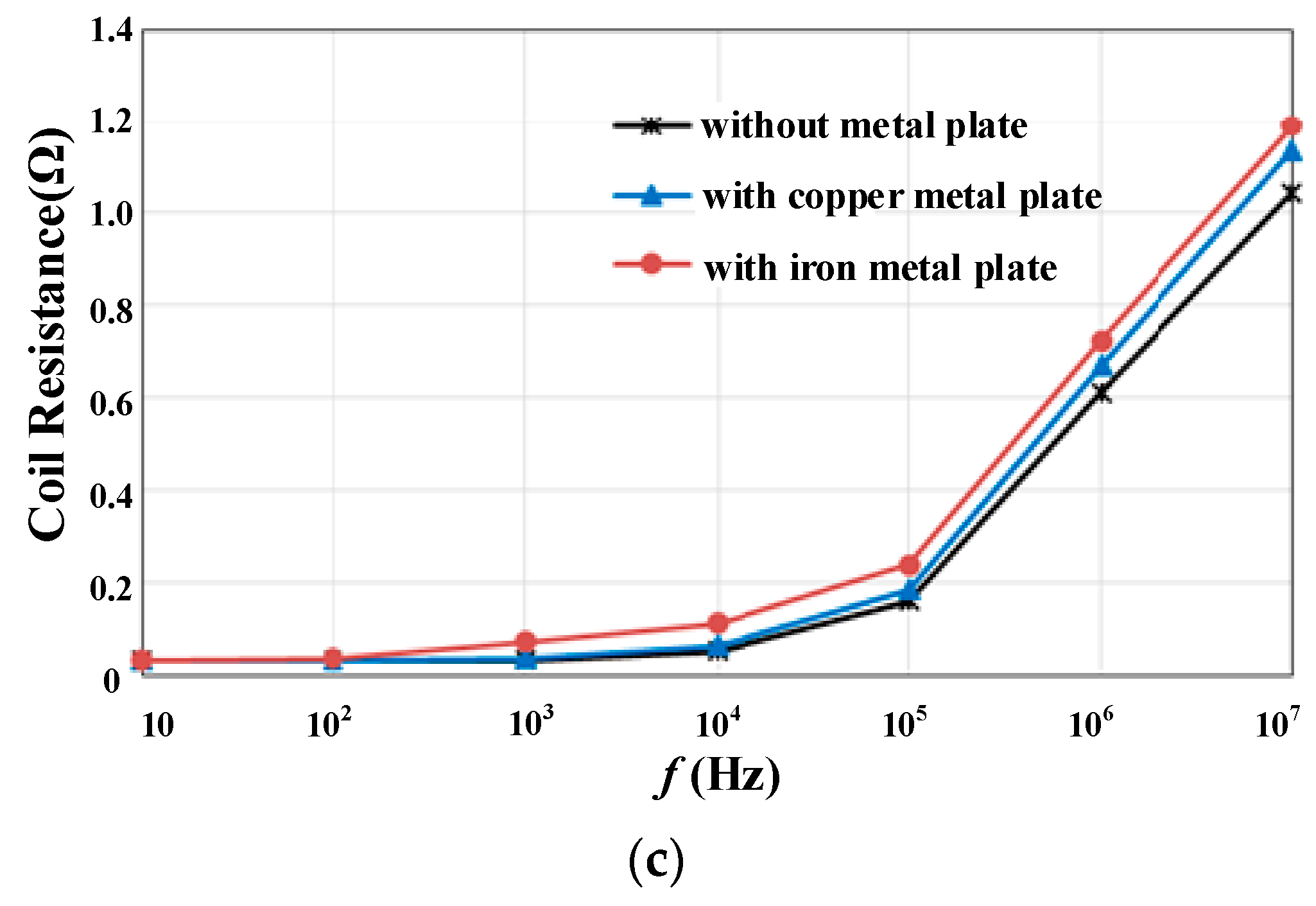
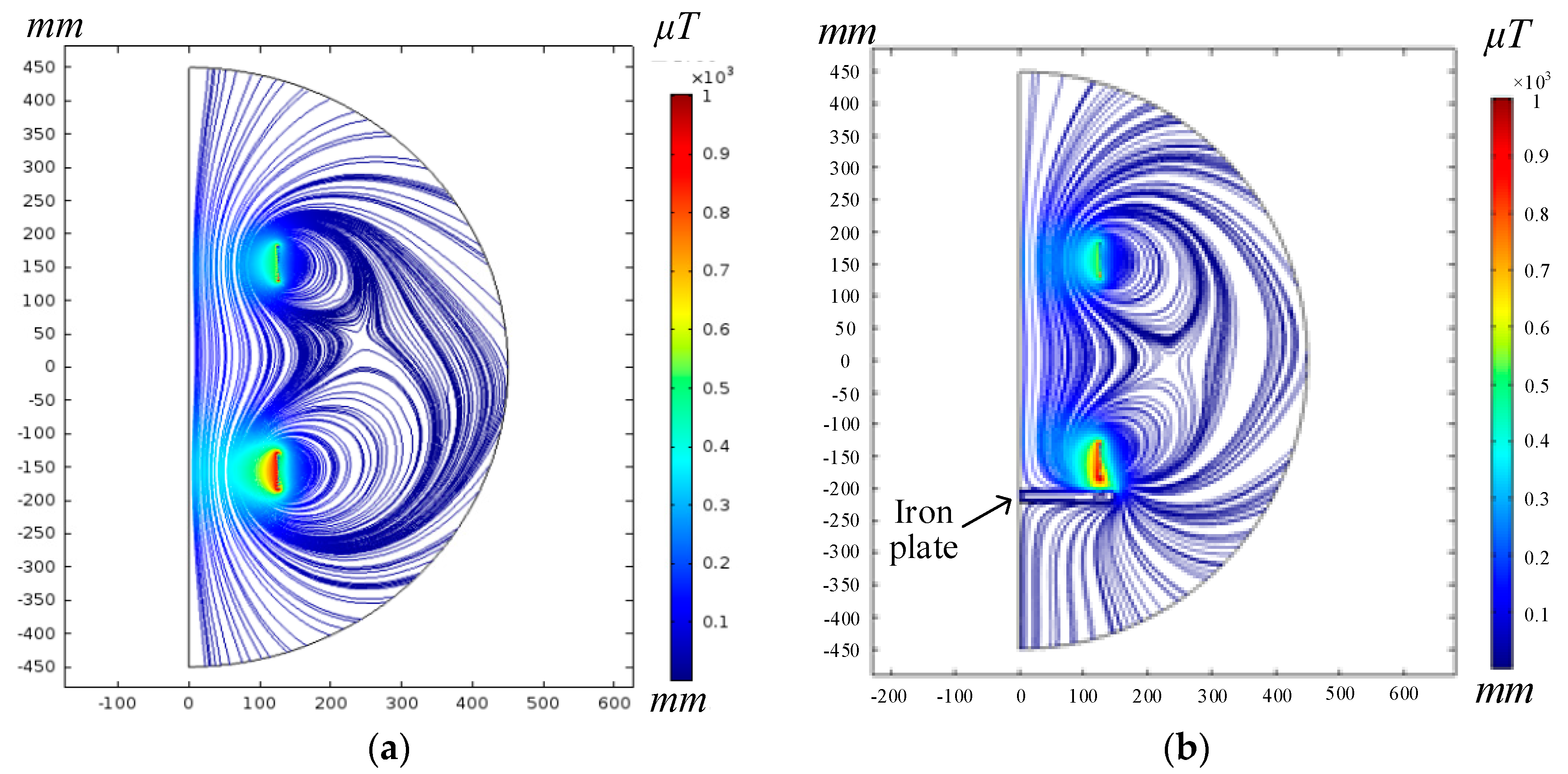

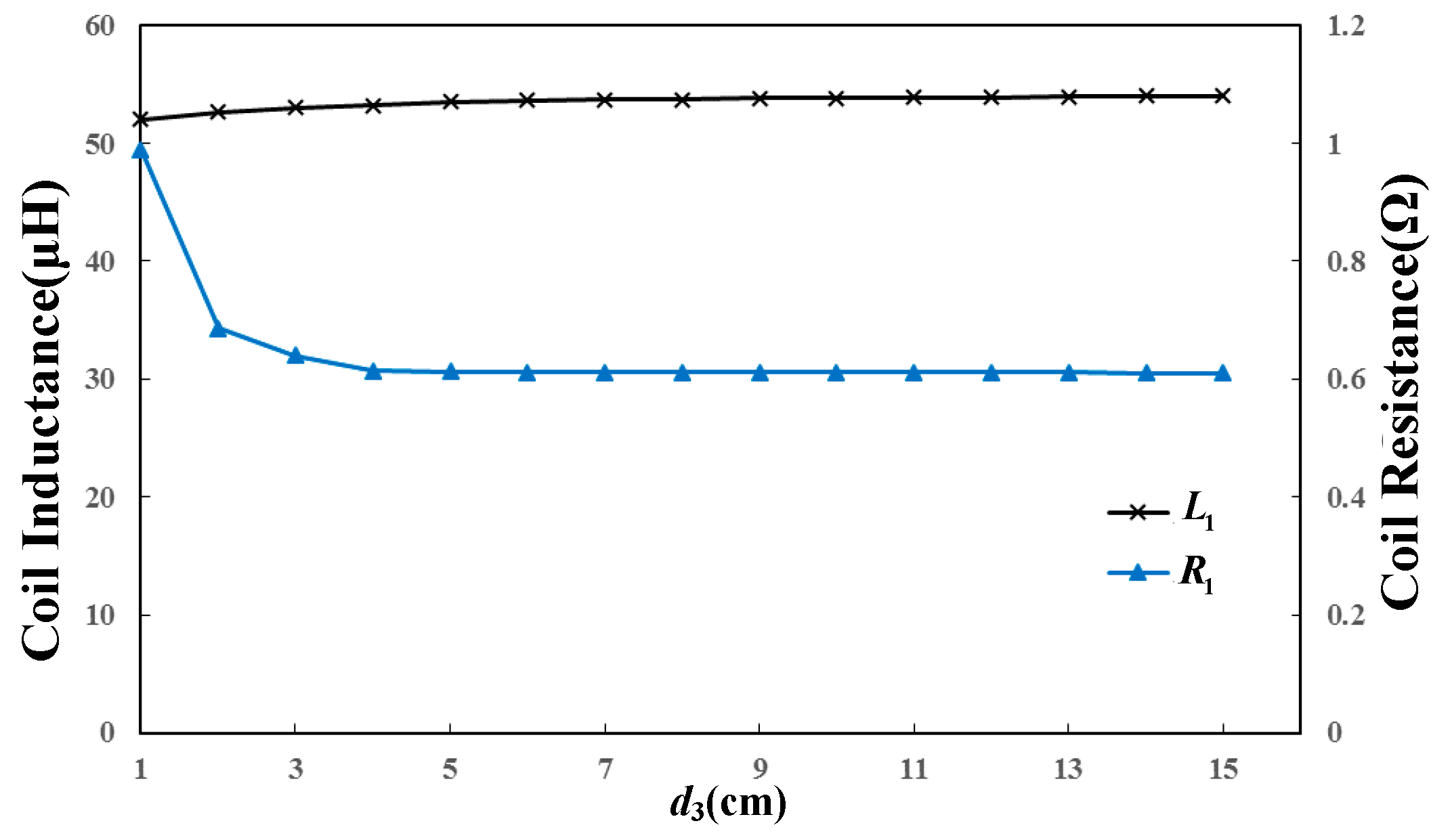
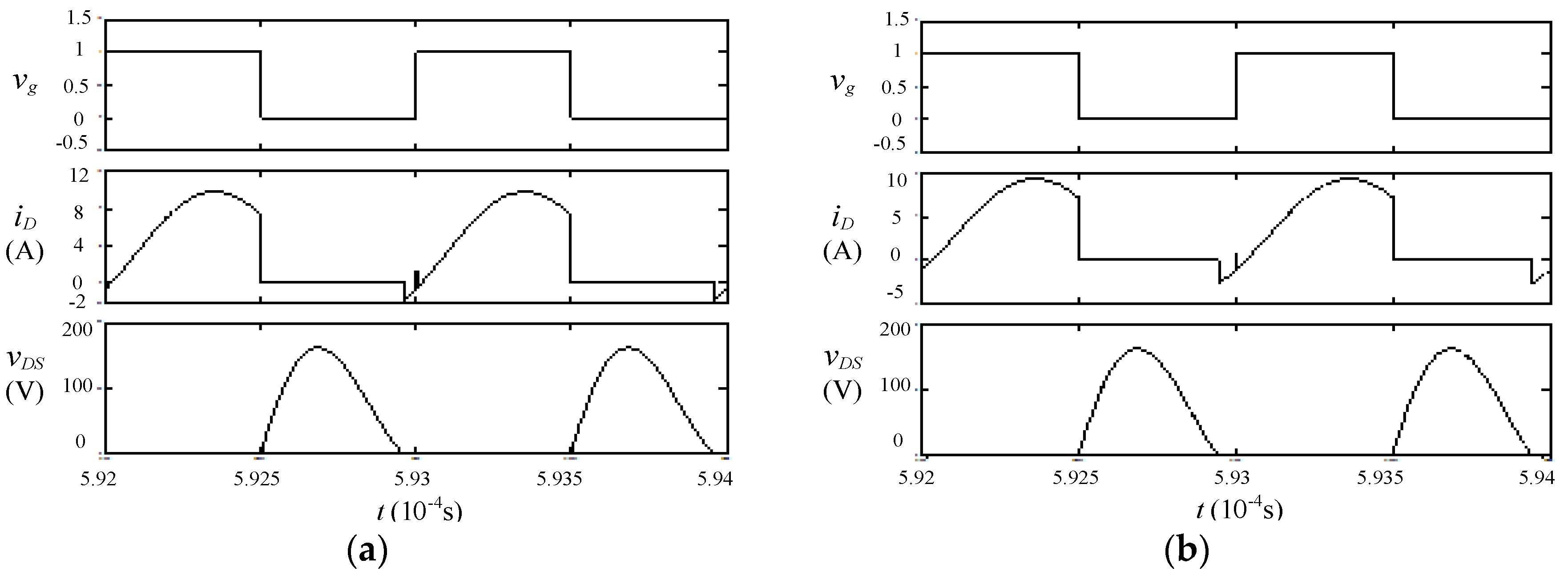



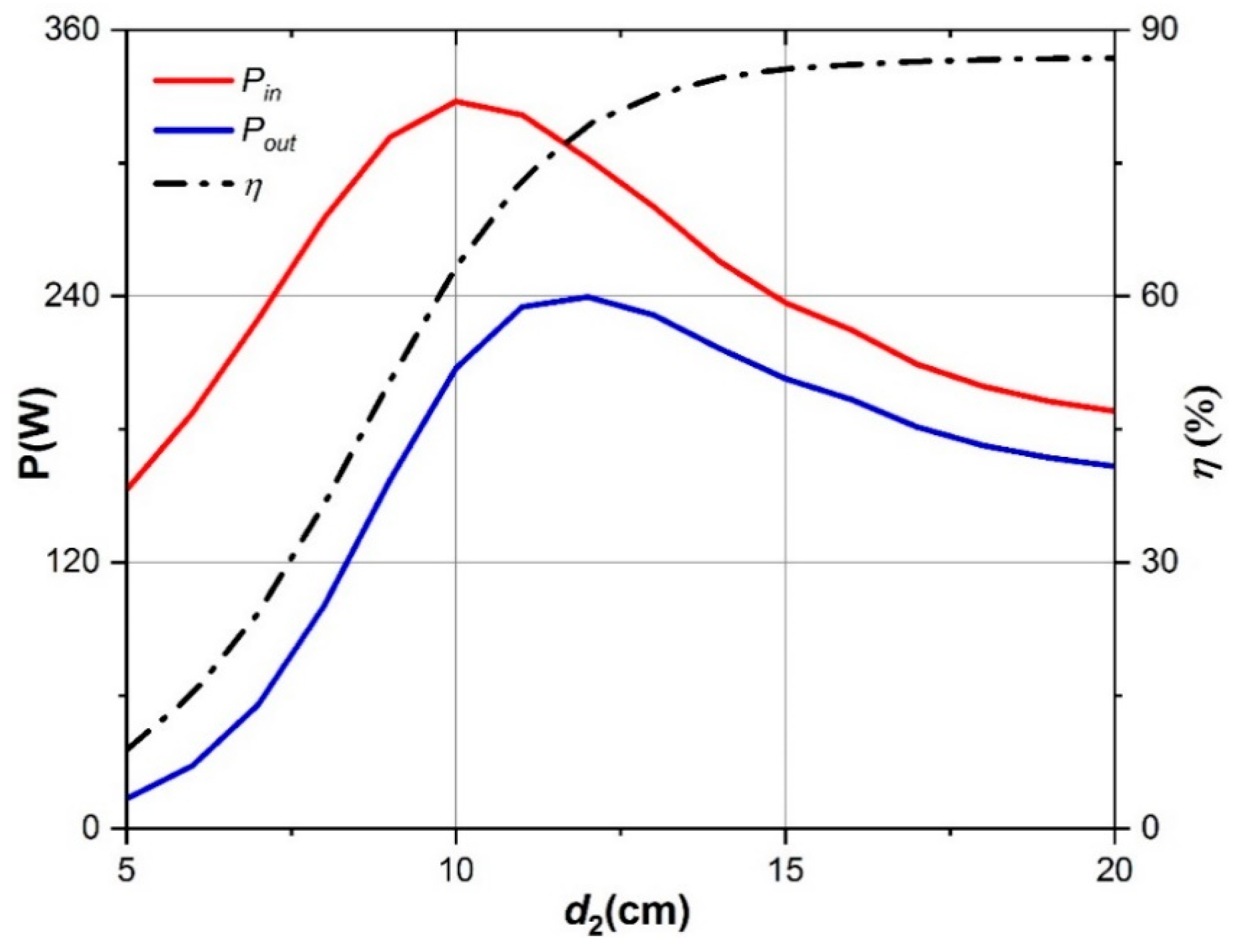
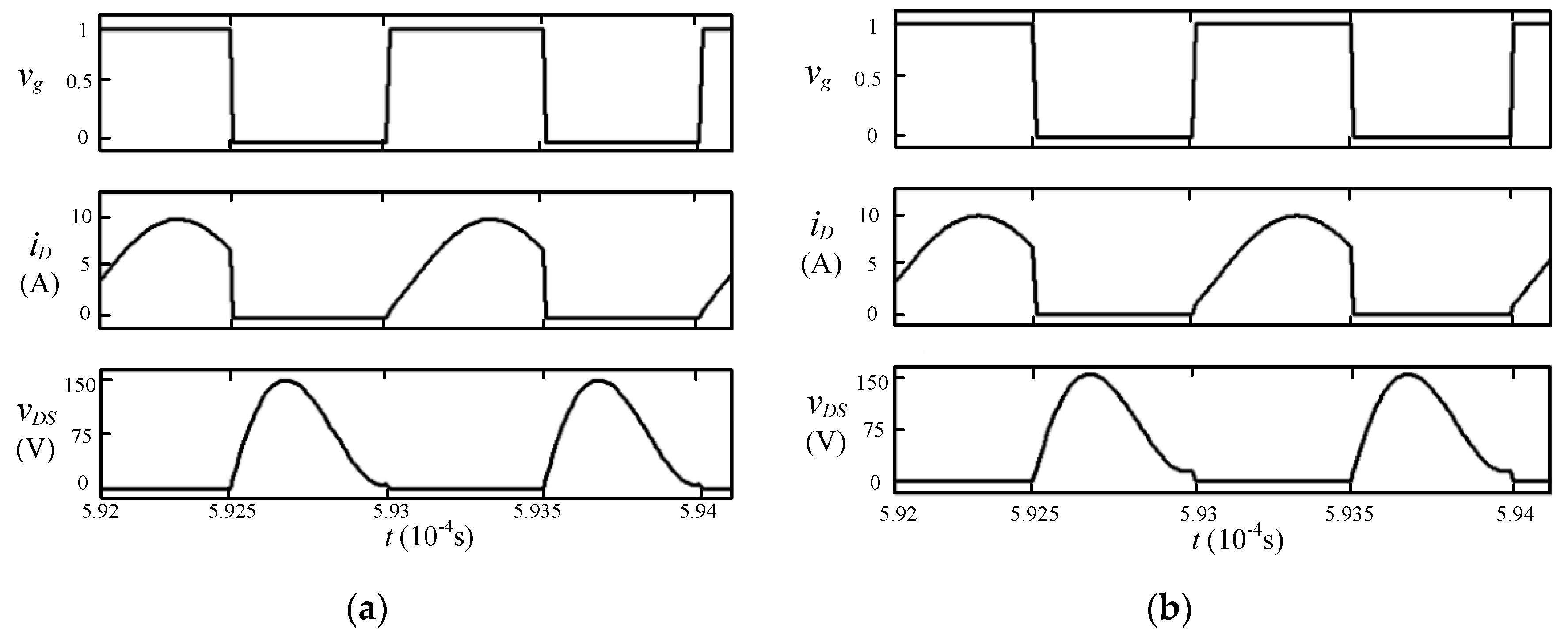

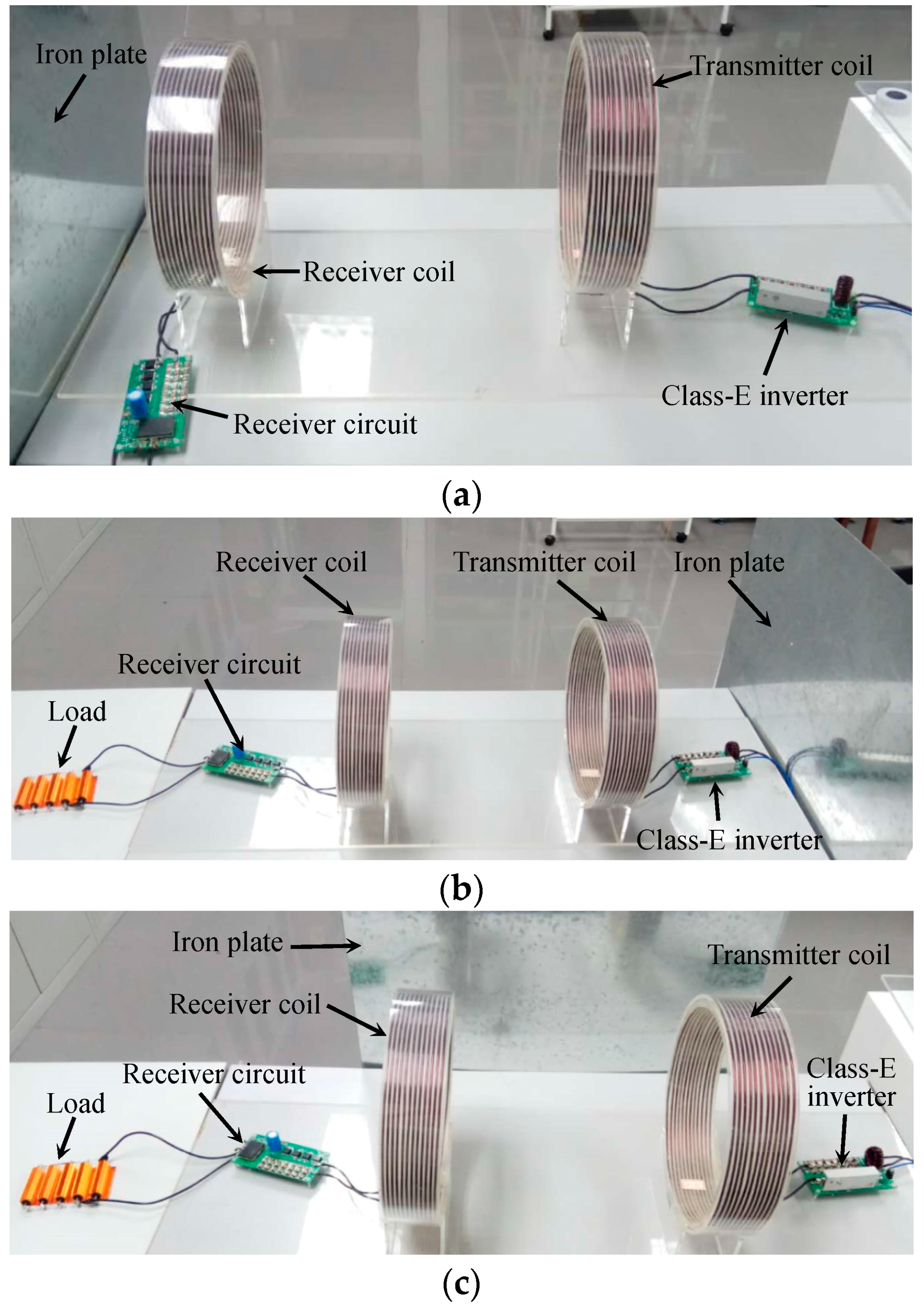
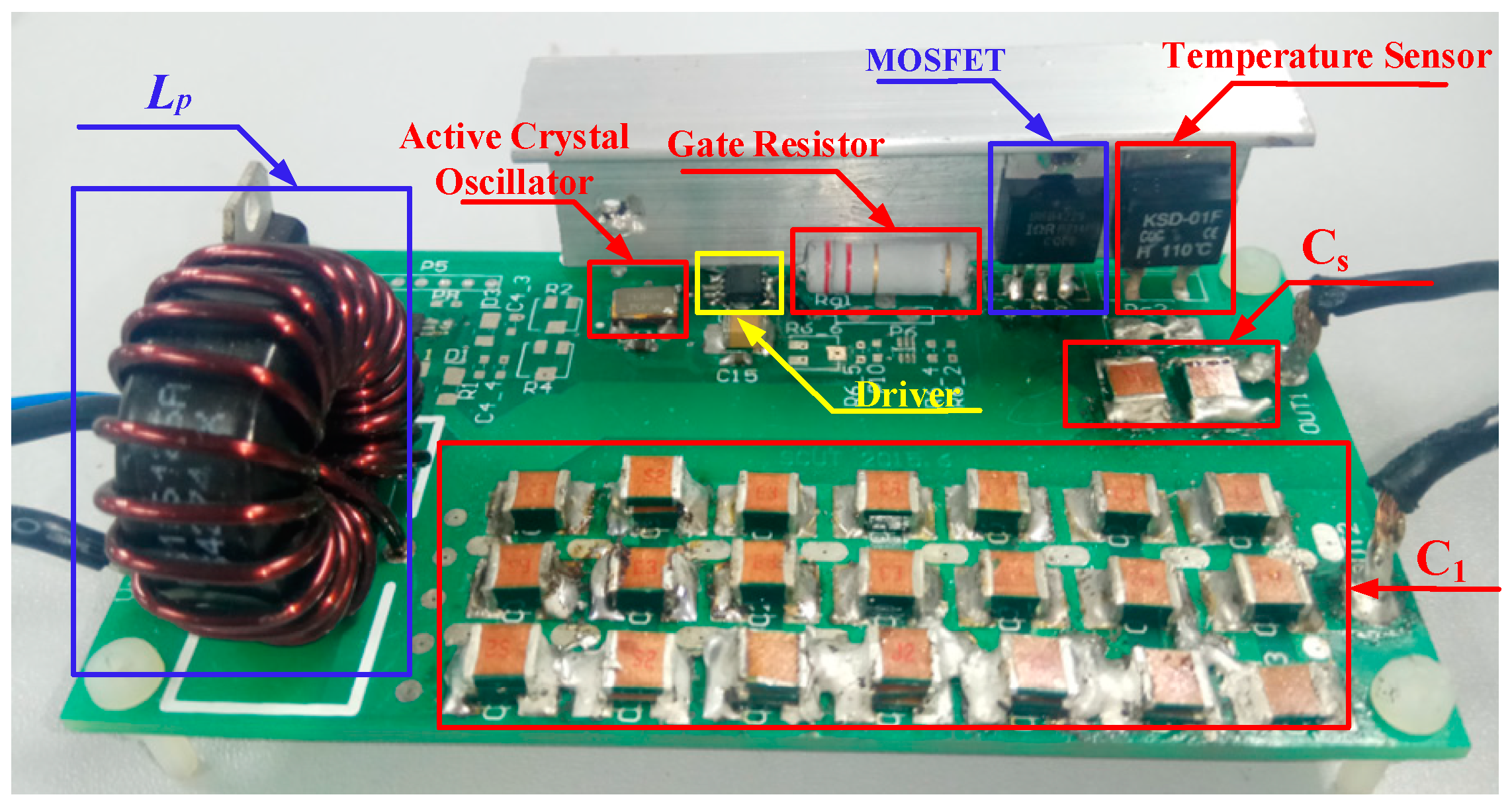



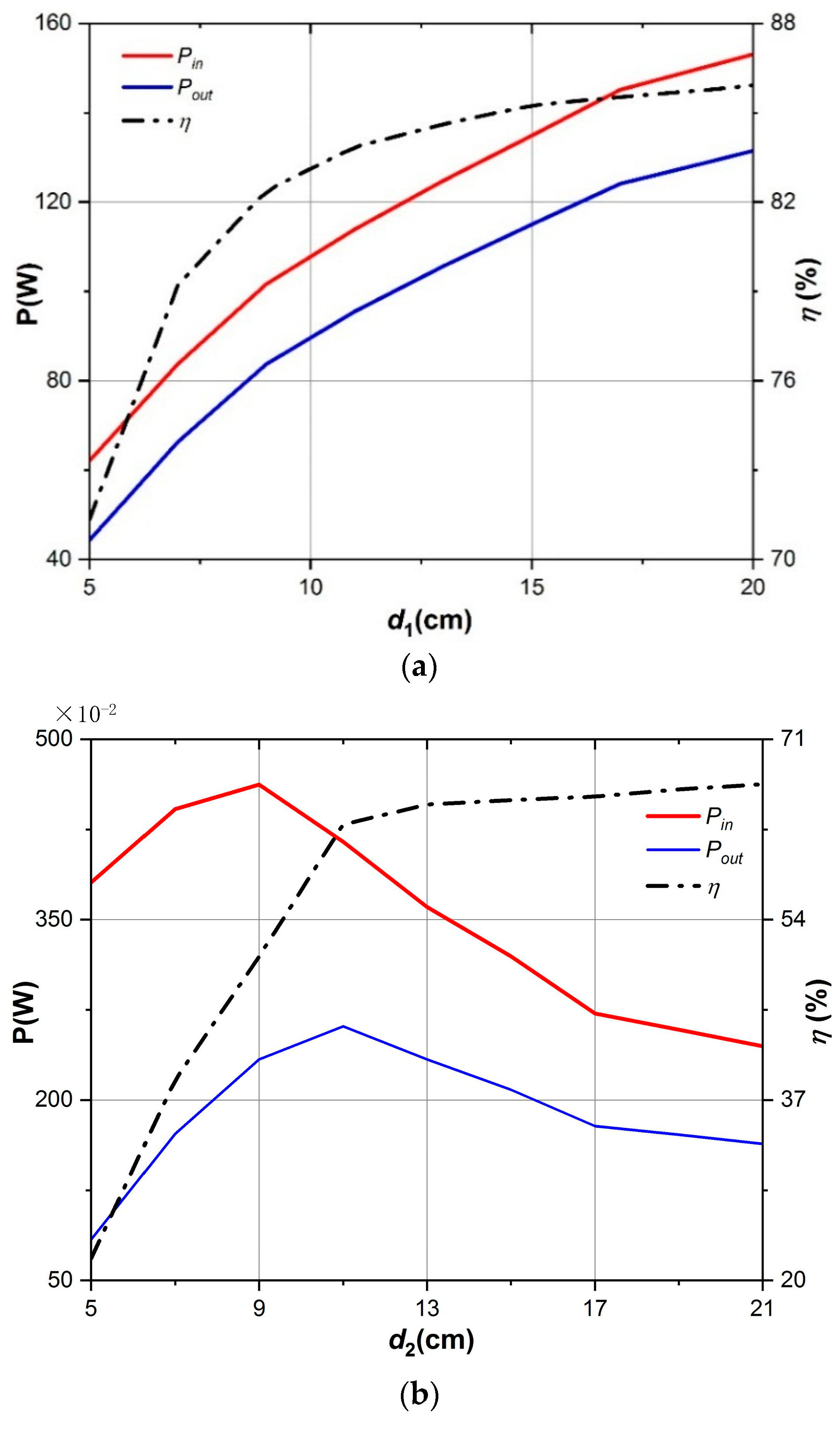
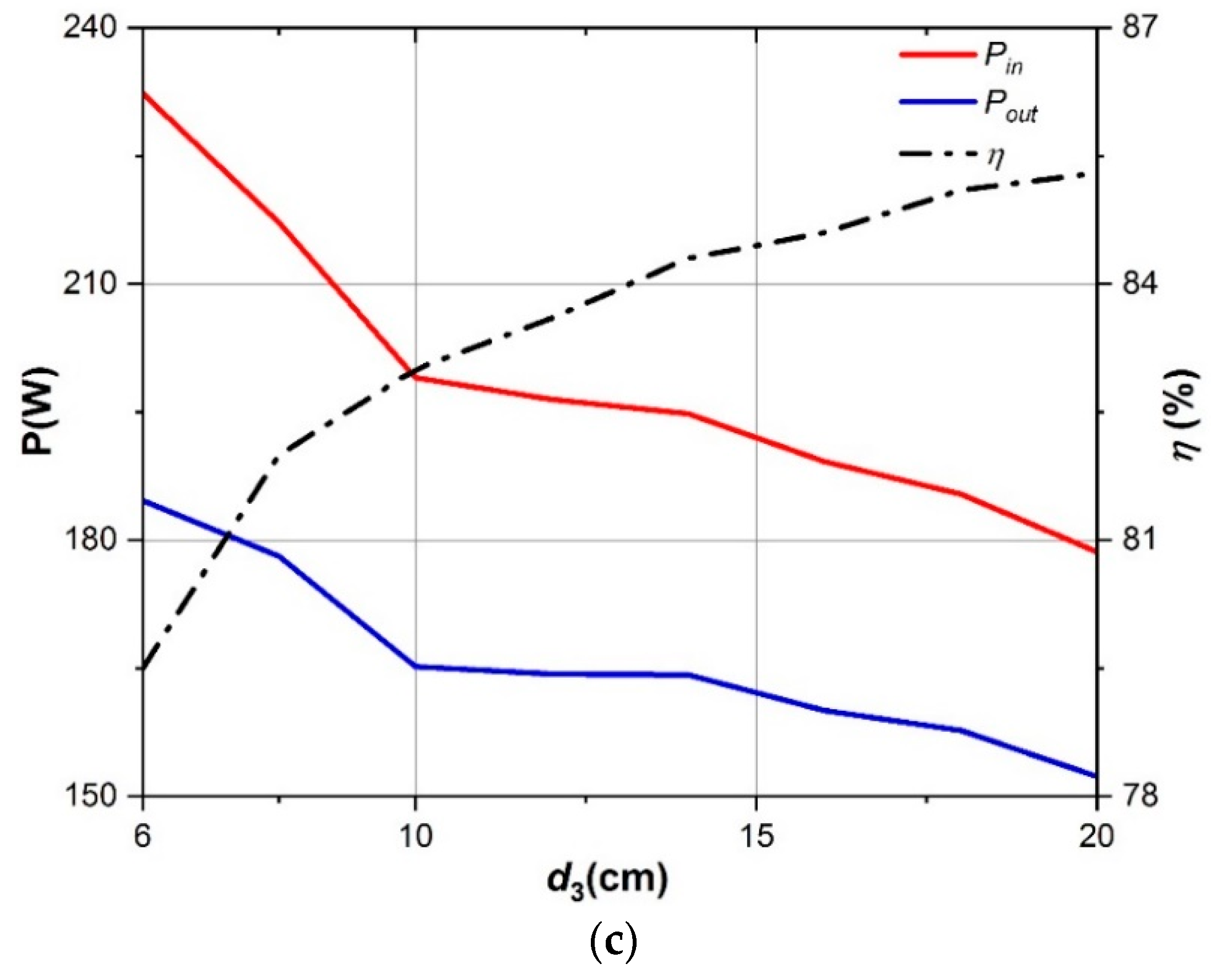


| Symbol | Parameter | Value |
|---|---|---|
| L1, L2 | Coil inductance | 54.47 μH |
| R1, R2 | Coil resistance | 0.61 Ω |
| M | Mutual inductance | 1.58 μH |
| D | Coil diameter | 25 cm |
| d | Diameter of coil wire | 2.5 mm |
| p | Pitch of helix coil | 2 mm |
| h | Height of helix coil | 52 mm |
| N | Coil turns | 12 |
| Db | Distance between coils | 26 cm |
| r | Radius of metal plate | 15 cm |
| t | Thickness of metal plate | 2 cm |
| Symbol | Parameter | Value |
|---|---|---|
| VDC | Input DC voltage | 45 V |
| RL | Load resistor | 14.3 Ω |
| Lp | Input choke inductor | 81 μH |
| Cs | Shunt capacitor | 4.1 nF |
| C1 | Transmitter compensation capacitor | 478.6 pF |
| C2 | Receiver compensation capacitor | 467 pF |
| f | Switching frequency | 1 MHz |
| f2 | Resonant frequency at receiver side | 1 MHz |
© 2018 by the authors. Licensee MDPI, Basel, Switzerland. This article is an open access article distributed under the terms and conditions of the Creative Commons Attribution (CC BY) license (http://creativecommons.org/licenses/by/4.0/).
Share and Cite
Xiao, W.; Shen, R.; Zhang, B.; Qiu, D.; Chen, Y.; Li, T. Effects of Foreign Metal Object on Soft-Switching Conditions of Class-E Inverter in WPT. Energies 2018, 11, 1926. https://doi.org/10.3390/en11081926
Xiao W, Shen R, Zhang B, Qiu D, Chen Y, Li T. Effects of Foreign Metal Object on Soft-Switching Conditions of Class-E Inverter in WPT. Energies. 2018; 11(8):1926. https://doi.org/10.3390/en11081926
Chicago/Turabian StyleXiao, Wenxun, Ruigeng Shen, Bo Zhang, Dongyuan Qiu, Yanfeng Chen, and Tian Li. 2018. "Effects of Foreign Metal Object on Soft-Switching Conditions of Class-E Inverter in WPT" Energies 11, no. 8: 1926. https://doi.org/10.3390/en11081926
APA StyleXiao, W., Shen, R., Zhang, B., Qiu, D., Chen, Y., & Li, T. (2018). Effects of Foreign Metal Object on Soft-Switching Conditions of Class-E Inverter in WPT. Energies, 11(8), 1926. https://doi.org/10.3390/en11081926




